Tauranga, according to our bus driver/tour guide, is like Auckland with the volume turned down several notches. The area around the port is resort-like with good surfing, lovely beaches, shops, restaurants, and a relaxed atmosphere.
The port itself is the largest and most efficient in the Southern Hemisphere. The claim to fame of greatest interest to us, however, is that a farm about an hour’s drive from Tauranga is the site of Hobbiton, the movie set used for the Peter Jackson films, The Lord of the Rings and The Hobbit.
Peter Jackson’s location scout was doing an aerial survey of the dairy land near Matamata, with specific goals in mind, green hills, water, and a huge oak tree that would serve as the “Party Tree” for Bilbo Baggins’ 111th birthday party. He found it on a farm owned by the Alexanders.
The extensive set was built into the hills, but in accordance with the agreement, was largely removed at the end of the film. Due to a cyclone, not everything was able to be removed and word spread about the hobbit holes on the farmer’s property and interested friends and then others came to see the remains of Hobbiton.
When Peter Jackson returned to film The Hobbit trilogy, Hobbiton needed to be rebuilt. This time, however, the set was built of more permanent materials and was not destroyed after the film. It has turned into a well maintained “Tourist Farm”. Each group of visitors is joined by a guide who points out features and tells stories of the set. You are not always in a crowd of people which gives time for photos. The largest hobbit hole (green door) at the bottom of the picture is Bag End, the home of Bilbo and later Frodo Baggins. This home is an actual movie set with room inside for over 100 people with movie equipment.

Most of the holes are facades with very limited space inside. We could recognize the homes of Samwise Ganges as well as Bag End. The huge party tree is also prominent on the grounds.

We were impressed by the detail and care that went into the design and execution of the set. There were cheese maker hobbits, baker hobbits, and even artist hobbits. The unique mailboxes for each home were also fun to see.

The grounds themselves are very well cared for by a small army of gardeners and provided habitats for lots of butterflies and even cicadas.

At the end of the tour, we had time for a pint of ale (or ginger beer) at the Green Dragon Inn, a scone, and a visit to the store. This excursion easily lived up to our expectations.


We have four ports to visit in New Zealand. The first of these is Auckland. On this tour, the tour guide was also the bus driver, so as we traveled down the left side of the road, we had commentary about the driving skills of the other drivers as well as the points of interest of the city. This is a harbor city with many boats to be seen. The cityscape is impressive with the Sky Tower above everything. A revolving restaurant is located on the top of the tower that we are told provides a wonderful view of the city and harbor.

After the city tour, we ended up at the War Memorial Museum. Half of this museum houses great exhibits featuring Polynesian carving and cultural information. My favorite exhibit was a Hotunui, an ancestral meeting house of the Ngāti Maru people. In Māori culture, these houses are representations of ancestors and held in the highest regard. We were asked to remove our shoes before entering.
The walls were adorned with carvings. The eyes were given life with iridescent abalone shells. Reeds were woven to provide insulation and decorative covering between the carvings. The overall effect was impressive.

Te Toki ā Tāpiri, the last great war canoe used in battle was carved from a single totara tree and displayed proudly.

Our guides told us about the weapons and materials used for weapons, tools, and boats. A part of the culture seen in the carvings and dances is to stick out the “tongue and look as intimidating as possible. One guide demonstrated his “look” that he worked on quite a lot.

These guides were also the “cast” of the cultural show we saw after the museum tour. The show had chants and songs as well as stories of the first Māori people who landed in New Zealand. The show finished with the Haka, a traditional war dance that has become more known because of the New Zealand rugby team who have done the Haka dance before matches.

The other half of the War Memorial museum involves the wars of New Zealand and the part that New Zealand played in the World Wars. On display are a British Spitfire and a Japanese Zero. A large memorial for New Zealanders killed in the World Wars holds a place of importance in the museum.


After we left Bora Bora we sailed Southwest towards Tonga. According to the calendar we sailed for four days but it really was only three as we crossed the International Dateline before we reached Tonga. We went to bed on February 19th and awoke on February 21st.
The Kingdom of Tonga is comprised of 170 islands of which only about 36 are populated. Until 2010 it was an absolute Monarchy. Today it is a constitutional monarchy. The capital city is Nuku’alofa on the main island of Tongatapu. The kingdom has a population of approx. 100,650 people, 70% of which live on the main island.
We arrived at Nuku’alofa early in the morning and the craft and souvenir vendors already lined the pier. We were also treated to welcoming music by a local brass band. Across from the ship you could see the royal palace of the current king.
We left our ship for our excursion entitled “Island Encounter & Ancient Tonga”.
We first drove to the royal palace for a closer look. Our guide told us that he was wearing the clothes one wore when visiting the King.
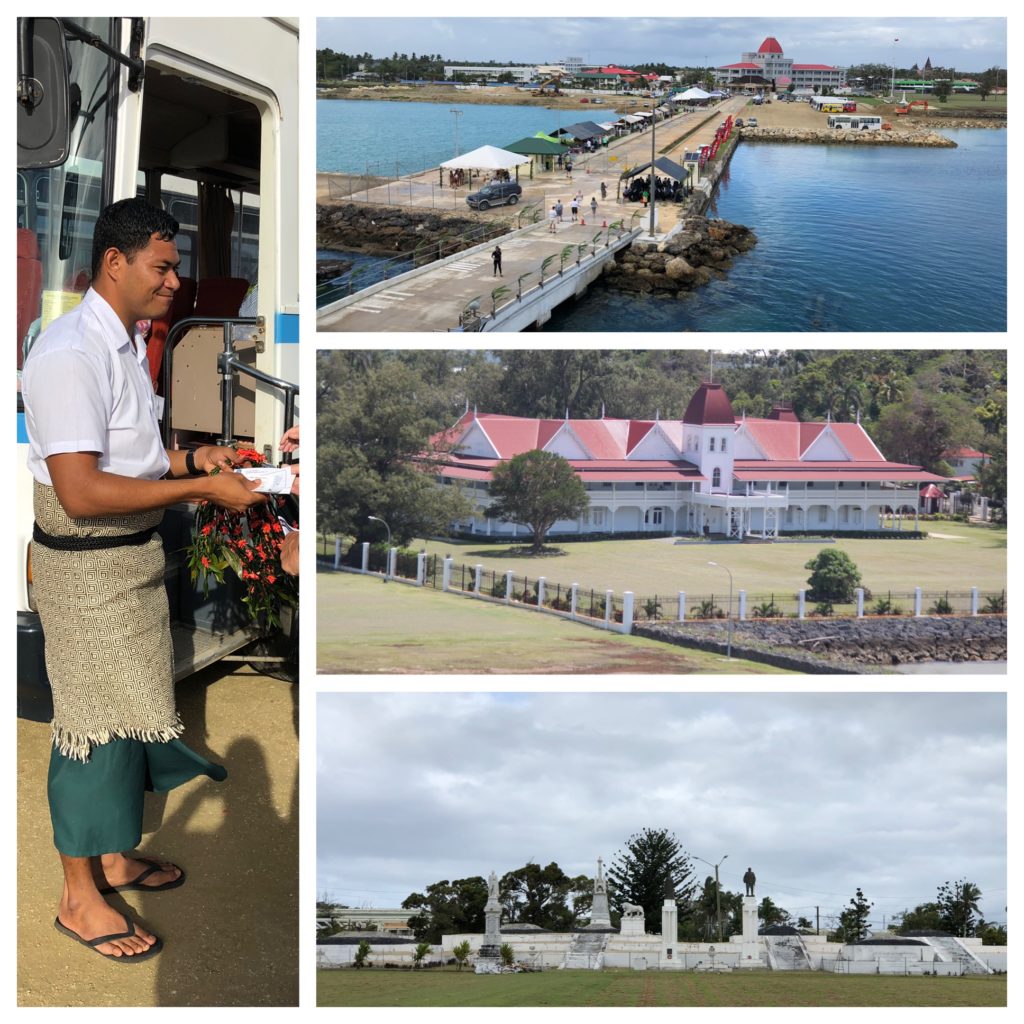
A distance behind the palace are the royal tombs. The tombs are usually decorated with brightly colored quilts, but due to the rain the previous day they decided not to display the quilts today. However a grave does not have to be royal for a quilt to be displayed. We’ve included a picture of one of the local cemeteries. It really is full of color and seems more like a celebration of life then death.
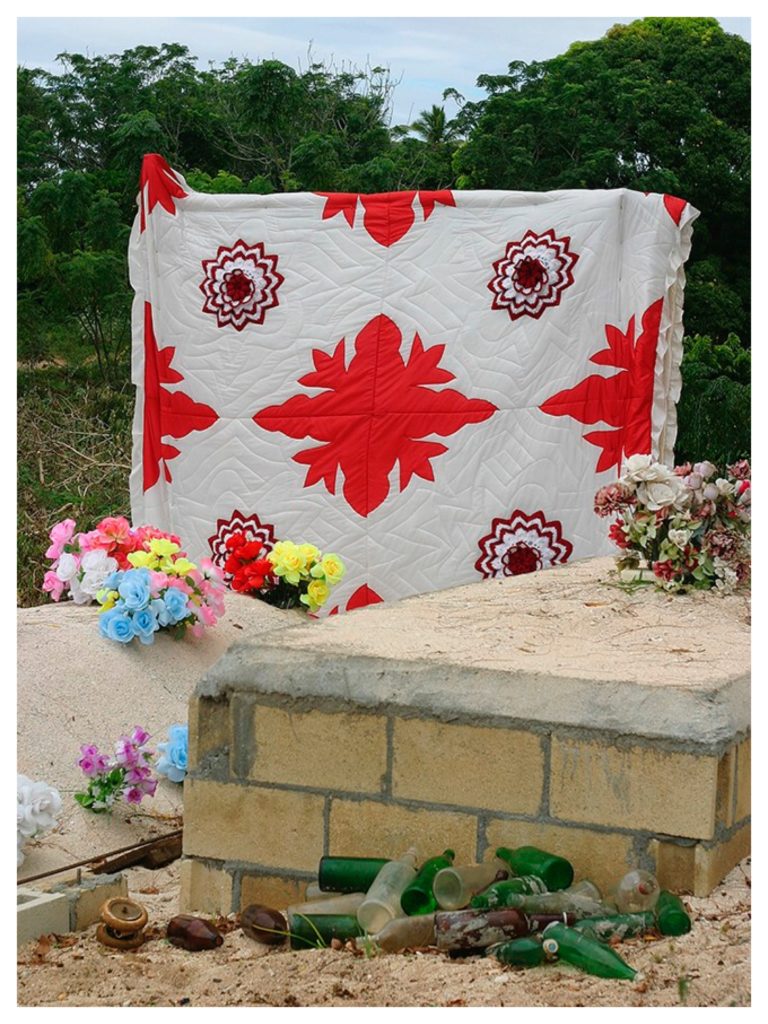
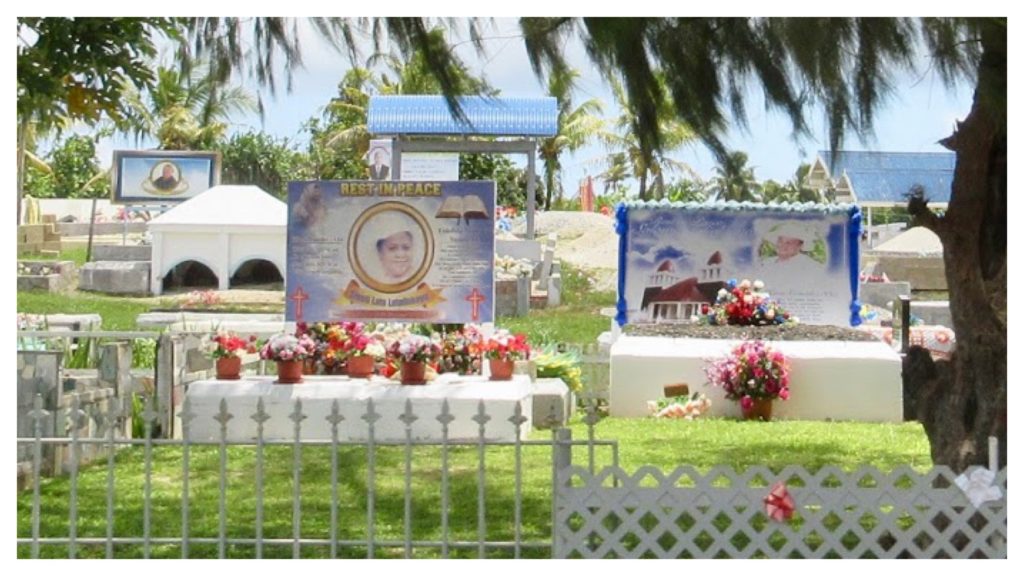
Next we went to the Ancient Tonga cultural show. The show was about two hours and covered Tongan music, dancing, ceremonies, customs, dress, cloth making, food preparations, and medicines. While this is a very Christian country (other religions are frowned upon), many of these rituals are still performed today. It was a great show and informative. Ancient Tonga is a family business and is operated by one extended family. The little boy is already being trained to become a drummer.
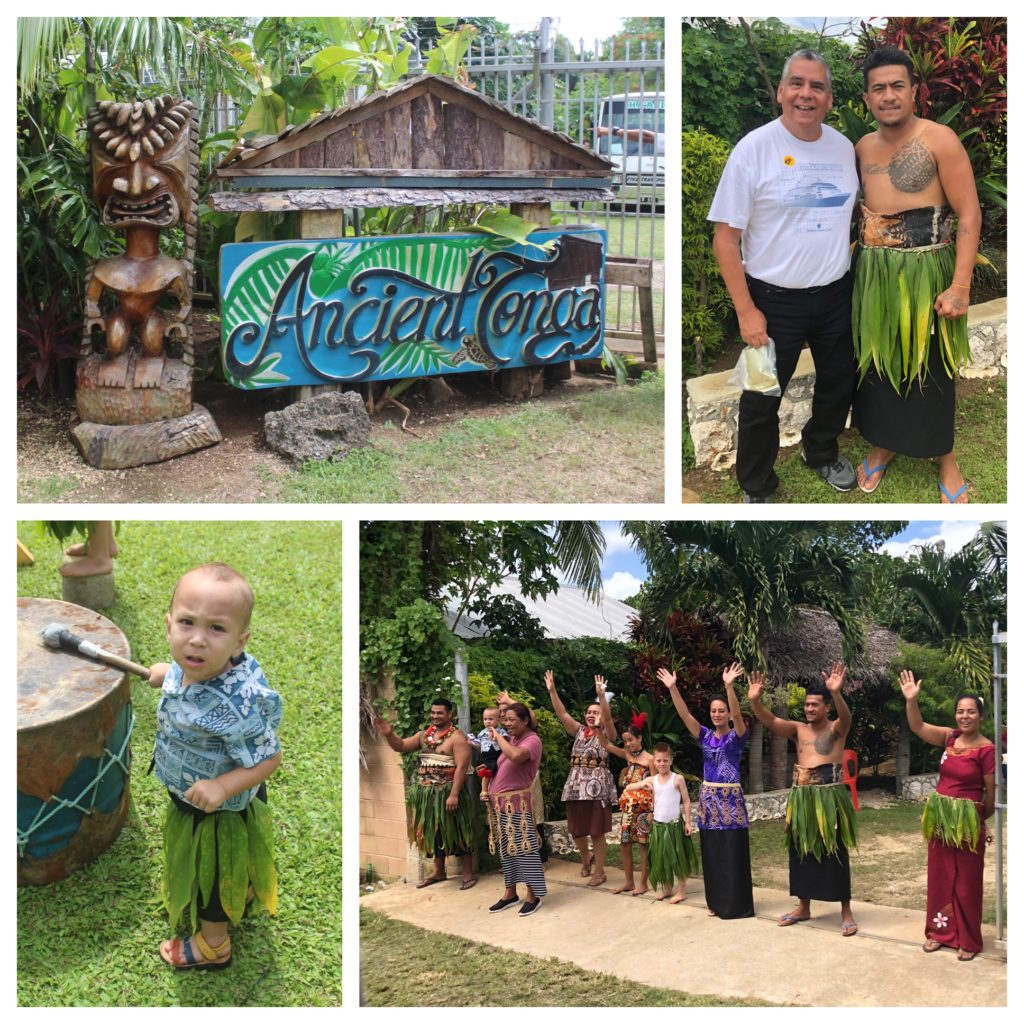
Lastly we visited a local blow hole at the beach. When we got back to the ship it was low tide and people were walking on the reefs collecting fish.
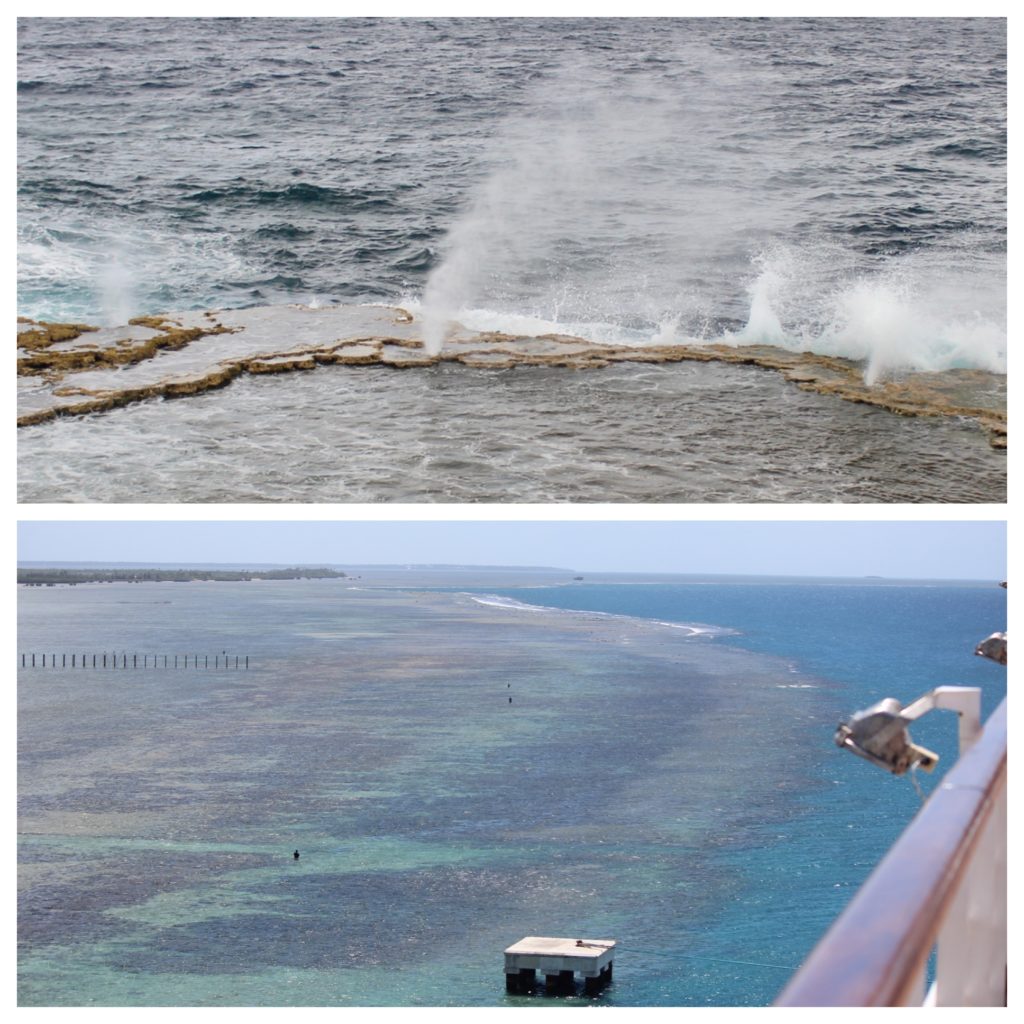
As we left, Tongan dancers wished us a final farewell.
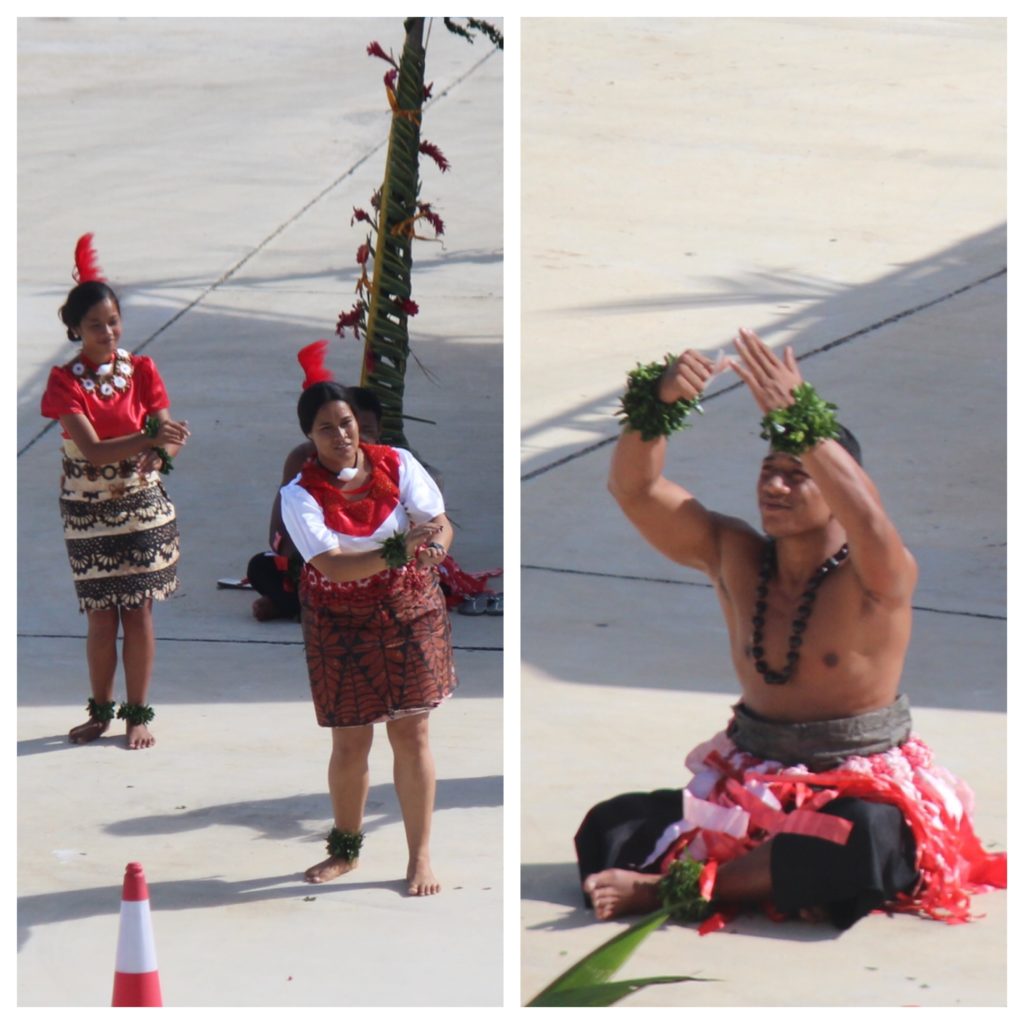
We left Papeete at 4:30 in the morning for a short couple of hours trip to Mo’orea. Unfortunately the storms were still in the area causing large ocean swells and the Captain decided to bypass Mo’orea and go on to Bora Bora. Since Mo’orea has no natural or man made breakwater, it would have been unsafe to use the Tenders to visit the island. From the looks of it (on the internet), Mo’orea would have been beautiful.

We sailed into the lagoon at Bora Bora around 7:00 pm and the Tenders began taking some passengers to shore if they wished. Not much was open so it was a quick trip back to the ship for them.
A quick note…Bora Bora is an extinct volcano with coral reefs encircling it which creates the lagoon. The main island is sinking causing the coral reefs to rise. After thousands of more years there will be no more island. All that will be left behind are the coral reefs and an atoll will have formed.
The next morning the sun was out and it turned into a beautiful day. Our excursion today was a trip around the island (were you surprised?). Our vehicle was not an air conditioned bus but a truck whose bed had been converted with seats and a rooftop.
Again the day was filled with some beautiful scenery.

When we came into the lagoon last night we saw one of the famous over the water bungalow resorts. To our surprise we found out there’s not just one resort but 5 of them. Also, they are not built on the main island but on the outlying reefs. If you’re interested in staying a night, prices start at around $1,000/night.
Along the way our guide pointed out small holes in the ground on the shoreline. These are crab holes. We stopped and he threw flowers on the ground amongst the holes. In a few seconds the crabs began crawling out of their holes, grabbing onto the flowers, and pulling them down into their holes! A couple of the crabs fought with each other over the same flower.
We also visited the only sandy beach on the island. It’s not very long but the waters were crystal clear. A local band was playing music while we were there. We would have loved to stay but we needed to keep moving.

At one of our stops the shop owners showed us how they decorate some of their local cloth. They start by tie-dying some cotton cloth. Then they stretch it out on a table to dry and cover it with various animal shaped pieces of linoleum. After a few hours the cloth has dried and when you remove the pieces of linoleum, the area under the linoleum is pale. The linoleum absorbed some of the color underneath it! They also demonstrated how to wear the cloth using some of the passengers as models.

Our last stop was at the bar/restaurant called “Bloody Mary’s”. It’s by frequented by a lot of Celebrities so you’ll never know who you might find there. It’s also expensive. Bloody Mary’s are $18.00 apiece! We only had time for one before we returned to the ship.

Next stop, the Kingdom of Tonga!
Two days after leaving Pitcairn Island we reached a very cloudy and subsequently rainy Papeete on Saturday morning. Papeete is a somewhat modern city. We’d planned on doing a bit of shopping after our excursion today but found out that all the stores close at 1:00 pm on Saturday and don’t reopen until Monday! So no shopping today.

We were greeted at the dock by a local group of Tahitian musicians/ singers. Around the corner we were met by a more polished group of singers and dancers. Between the two I preferred the local group and their music as it seemed to be played from the heart.

Our excursion today was a trip around the island. There is one main two lane highway(?) and it took us about 6 hours to go all the way around the island with several stops along the way.
Our first stop was at the writer James Norman Hall’s house. (Here’s a question for you: what does Hall have to do with a restaurant in Van Nuys, CA? Read on.)

James Hall was an American born in Colfax, Iowa. He was in England in 1914 when WWI started. He posed as a Canadian and joined the British Army. He was discharged after his true nationality was discovered. In 1916 he joined the Lafayette Flying Corps of the famous Lafayette Escadrille that trained American volunteers to serve in regular French squadrons. When America entered the war in 1917 he was transferred to the Army Air Service into the 94th Aero Squadron (Whew! At last! The tie-in to the Van Nuys 94th Aero Squadron restaurant). He was also a highly decorated pilot by the French and American governments. It was during this time he met fellow pilot Charles Nordhoff.
After the war both Hall and Nordhoff eventually moved to Tahiti where they collaborated on a series of books, the most famous of which is “Mutiny On The Bounty”. The subsequent movies about the Bounty are based on this book.
Hall had two children. His son, Conrad Hall, became a cinematographer in Hollywood and won 3 Academy Awards for his work on “Butch Cassidy and the Sundance Kid”, “American Beauty”, and “Road To Perdition”.
Lastly, the fruit you see in the picture above are breadfruits. The tree bearing this fruit is an offshoot from one of the three surviving trees taken from Tahiti and delivered to Jamaica by Captain Bligh of Bounty fame on his second voyage in 1799!
Next up was lunch! We visited a private home owned by a couple who host private functions there. They had set up a large tent with tables and chairs, all decorated with local plants and flowers many of which came from their gardens (top two flowers below). They had a large buffet of local faire which included Poisson Cru (a fish dish similar to Ceviché), taro, breadfruit, Coconut bread, assorted other tropical fruit, and, three main dish courses of chicken, fish, and beef. The food was great. In the garden was a giant Banyan tree. You can see how it dwarfs Paul.

After lunch we continued our trip eventually stopping at “Jardin de Vaipahi”, a man-made water garden surrounding a beautiful waterfall with lovely gardens. We also saw some very beautiful flowers (bottom two flowers below). I don’t think I’ve ever seen the flower on the left.

Shortly after we left the Gardens, we arrived back in Papeete. It was a great day and we saw some great scenery throughout the day.
Paul and I had heard that food trucks setup in a Park right by our ship and we looked forward to trying some Polynesian fast food. Alas it was not to be for as soon as we got back to the ship, the winds started blowing and it began to rain cats and dogs! Instead we ate on the ship. While the storm was howling outside, we were entertained by a local cultural group with Tahitian songs and dances.

All in all it was a great day visit to Tahiti. Tomorrow we visit the island of Mo’orea.